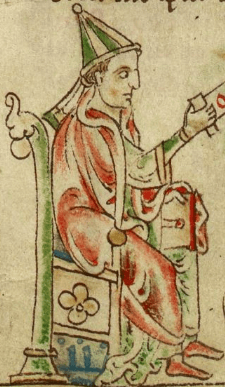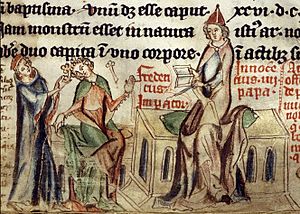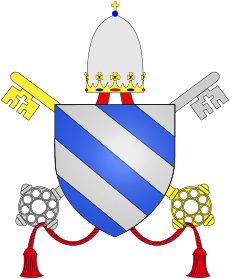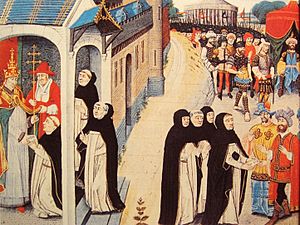Pope Innocent IV facts for kids
Quick facts for kids Pope Innocent IV |
|
|---|---|
| Bishop of Rome | |

Innocent IV excommunicating emperor Frederick II at the Council of Lyon, 13th century
|
|
| Church | Catholic Church |
| Papacy began | 25 June 1243 |
| Papacy ended | 7 December 1254 |
| Predecessor | Celestine IV |
| Successor | Alexander IV |
| Orders | |
| Consecration | 28 June 1243 |
| Created Cardinal | 18 September 1227 |
| Personal details | |
| Birth name | Sinibaldo Fieschi |
| Born | c. 1195 Genoa or Manarola, Republic of Genoa |
| Died | 7 December 1254 (aged 58–59) Naples, Kingdom of Sicily |
| Previous post | Cardinal-Priest of San Lorenzo in Lucina (1227–1243) |
Pope Innocent IV (born Sinibaldo Fieschi, around 1195 – 7 December 1254) was a very important leader of the Catholic Church. He was the head of the Church and also ruled the Papal States (lands controlled by the Pope) from June 25, 1243, until he died in 1254.
Sinibaldo Fieschi was born in Genoa, Italy. He studied law at famous universities in Parma and Bologna. People at the time thought he was an excellent lawyer. Because of his skills, he was asked to work for the Pope in Rome.
Later, Pope Gregory IX made him a cardinal. A cardinal is a high-ranking official in the Catholic Church. In 1235, he became the governor of a region called the March of Ancona.
In 1243, Fieschi was chosen to be the new Pope. He took the name Innocent IV. As Pope, he faced a big problem: a disagreement with the Holy Roman Emperor, Frederick II, over land. To stay safe from the Emperor's plans, Pope Innocent IV moved to France. He returned to Rome after Emperor Frederick II died in 1250.
Contents
- Early Life and Education
- Becoming a Cardinal
- A New Pope, The Same Emperor
- The First Council of Lyon
- After the Council
- Pope's Power Over Rulers
- Northern Crusades
- Church Matters and New Orders
- Changes to the Talmud Policy
- Relations with Jewish Communities
- Diplomatic Relations
- Later Years and Conflicts
- The Final Battle
- See also
Early Life and Education
Sinibaldo Fieschi was born in Genoa, Italy, around 1195. His parents were Beatrice Grillo and Ugo Fieschi, who was a Count. The Fieschi family was a well-known merchant family from the Liguria region.
Sinibaldo went to school at the University of Parma and the University of Bologna. He became known as one of the best canon lawyers (Church law experts) of his time. He even wrote a famous book about papal laws.
From 1216 to 1227, he worked as a church official in the Cathedral of Parma. His skills quickly led him to work for Pope Honorius III in Rome. He rose through the ranks very fast.
Becoming a Cardinal
On September 18, 1227, Pope Gregory IX made Sinibaldo Fieschi a Cardinal-Priest. This was a very important position. He then served as a papal governor in the March of Ancona from 1235 to 1240.
Pope Innocent IV's time as Pope was connected to the Popes before him, like Innocent III, Honorius III, and Gregory IX. When Pope Gregory IX died, he was trying to get back lands that Emperor Frederick II had taken from the Papal States.
Pope Gregory IX had called a big meeting of Church leaders to remove the Emperor from power. But Frederick II captured two cardinals who were on their way to the meeting. This caused problems for the next papal election.
A New Pope, The Same Emperor
After a long debate and some pressure, the cardinals finally chose a new Pope. On June 25, 1243, Cardinal Sinibaldo de' Fieschi was elected Pope. He was hesitant to accept the role. He chose the name Innocent IV.
Before he became Pope, Sinibaldo was friends with Emperor Frederick II. The Emperor even admired Sinibaldo's wisdom. When Sinibaldo became Pope, Frederick joked that he had lost a friend but gained an enemy.
Despite the joke, Frederick wrote a respectful letter to the new Pope. He congratulated Innocent IV and hoped they could solve their disagreements. However, the talks did not go well. Innocent IV would not give up his demands, and Frederick II would not agree. The main issue was about returning the region of Lombardy to the Pope.
The Emperor's actions caused many people in Italy to turn against the Pope. Innocent IV realized he was not safe in Rome. So, on June 7, 1244, he secretly left Rome. He traveled in disguise to Genoa, his hometown. From there, he went to France, where he was welcomed. He arrived in Lyon on November 29, 1244.
In Lyon, Pope Innocent IV felt safe from Frederick II. On December 27, 1244, he called for a big meeting of Church leaders. About 140 bishops came to this meeting, which was called the First Council of Lyon. It was the first time such a council was held in Lyon. Their main goal was to deal with Emperor Frederick II.
The First Council of Lyon

The First Council of Lyon in 1245 was a smaller meeting than some other Church councils. However, three patriarchs (high-ranking bishops) and the Latin Emperor of Constantinople attended. About 150 bishops were there, mostly from France and Spain. These bishops could come quickly and support Pope Innocent.
Bishops from other parts of Europe were afraid of Frederick II. Many others could not attend because of invasions by the Mongols or Muslims. A bishop from Russia, Peter, attended and shared information about the Mongols.
During the meeting, Frederick II's lawyer, Taddeo of Suessa, defended the Emperor. He repeated all the promises Frederick had made before. But he refused to give the guarantees the Pope wanted. On July 17, the Council decided to officially remove Emperor Frederick II from power and excommunicate him. This meant he was no longer considered a member of the Church. All his subjects were also freed from their loyalty to him.
After the Council
This decision caused a lot of political trouble across Europe. The chaos continued until Frederick II died in December 1250. His death meant Innocent IV was no longer in immediate danger. He could finally return to Italy.
He left Lyon on April 19, 1251, and arrived in Genoa on May 18. He then traveled through Italy, reaching Perugia in November. He stayed in Perugia until it was safe to bring the papal court back to Rome. He finally returned to Rome in October 1253.
Innocent IV then left Rome again in April 1254. He focused on who would take over Frederick II's lands, especially the Kingdom of Sicily. Innocent IV continued to oppose Frederick's family, the Hohenstaufens. This led to many conflicts in Italy for the next 30 years.
Pope Innocent IV died in Naples on December 7, 1254. He was following his army, which was trying to defeat Frederick's son, Manfred.
While in Perugia, on May 15, 1252, Innocent IV issued a special order called Ad extirpanda. This order had 38 laws. It told local leaders in Italy to treat heretics (people who went against Church teachings) as criminals. It also set limits on using torture to get information.
Pope's Power Over Rulers
Like Pope Innocent III before him, Innocent IV believed he was the "Vicar of Christ." This meant he thought his power was above that of earthly kings. So, he felt he could get involved in matters that were not strictly religious.
For example, he appointed Afonso III of Portugal as the administrator of Portugal. He also protected Ottokar II of Bohemia, the son of the King of Bohemia. The Pope even supported King Henry III of England against his own nobles and bishops.
Innocent IV also believed he could tell non-Christians what to do. He thought he could punish them if they broke God's laws. This idea was more of a theory and was later changed centuries later.
Northern Crusades
Soon after Innocent IV became Pope, the Teutonic Order (a group of knights) asked for his help. They wanted to stop a rebellion in Prussia and fight against the Lithuanians.
On September 23, 1243, the Pope issued a special order called Qui iustis causis. This order allowed crusades (holy wars) in Livonia and Prussia. This order was reissued several times by Innocent and later Popes.
Church Matters and New Orders

The Pope was very busy with political issues and conflicts with rulers. This meant that some internal Church matters were not given as much attention. For example, the Papal States had higher taxes, which made people unhappy.
However, Innocent IV did try to improve the spiritual side of the Church. He did this in several ways.
Making Saints
In 1246, Edmund Rich, a former Archbishop of Canterbury, was declared a saint. In 1250, the Pope also made Saint Margaret of Scotland, a queen, a saint.
Two other people were made saints in 1253:
- Peter of Verona, a Dominican priest who was killed by heretics.
- Stanislaus of Szczepanów, a Polish Archbishop.
Supporting New Religious Groups
In August 1253, Innocent IV officially approved the rules for the Poor Clares nuns. This was the second order of the Franciscans, founded by St. Clare of Assisi. She was a friend of St Francis. The Pope had worried about their strict rule of poverty, but he finally approved it.
Changes to the Talmud Policy
Earlier, Pope Gregory IX had ordered all copies of the Talmud (a collection of Jewish laws and traditions) to be taken from Jewish people in France. In 1240, many copies of the Talmud were burned in Paris.
At first, Innocent IV continued this policy. In 1244, he ordered that the Talmud be examined by scholars at the University of Paris. If they found it wrong, it should be burned.
However, some people argued that this went against the Church's usual tolerance for Judaism. So, on August 2, 1247, Pope Innocent IV changed his mind. He ordered that the Talmud should be censored (parts removed or changed) instead of being completely burned. This new policy was continued by later Popes.
Relations with Jewish Communities
In April 1250, Pope Innocent IV told the Bishop of Córdoba to act against Jewish people. They were building a synagogue (a Jewish house of worship) that was too tall for the local clergy's liking.
Diplomatic Relations
With Portugal
Innocent IV played a role in removing King Sancho II of Portugal from power. This happened at the request of Sancho's brother, Afonso. One reason the Pope used was that Sancho II was too young when he became king.
With the Mongols

The Pope was also worried about the Mongols and their warlike actions. In 1245, he sent a special messenger, Giovanni da Pian del Carpine, to the "Emperor of the Tartars" (Mongols). The message asked the Mongol ruler to become Christian and stop attacking Europe.
The Mongol leader, Güyük Khan, replied in 1246. His letter, which is still in the Vatican Library, demanded that the Pope and other European rulers surrender to him.
Innocent IV sent other missions to the Mongols as well. In 1245, he sent Ascelin of Lombardia, who met with the Mongol ruler Baichu in 1247. Baichu's reply was similar to Güyük's. He also sent two Mongol envoys to the Pope in Lyon. In 1248, these envoys met Innocent, who again asked the Mongols to stop harming Christians.
Later Years and Conflicts
Even with other concerns, Innocent IV spent his later years trying to overthrow Manfred of Sicily. Manfred was the natural son of Frederick II and had taken over his father's lands. Innocent wanted to add the entire Kingdom of Sicily to the Papal States. But he did not have enough money or power.
So, he made a deal with Edmund Crouchback, the nine-year-old son of King Henry III of England. On May 14, 1254, Innocent made Edmund the King of Sicily.
In the same year, Innocent excommunicated Frederick II's other son, Conrad IV. Conrad died a few days after Edmund was made king. Innocent spent the spring of 1254 in Assisi and then moved to Anagni. He was waiting to see how Manfred would react.
Manfred seemed to give in at first. He accepted the title of papal vicar for southern Italy. This meant Innocent was, in theory, the ruler of most of Italy. However, Innocent pushed too hard. He accepted the loyalty of the city of Amalfi directly to the Pope, instead of to the Kingdom of Sicily.
Manfred immediately fled and gathered his troops. He began to use military force to make towns and nobles loyal to him again.
The Final Battle
Realizing Manfred would not surrender, Innocent and his papal army headed south from Anagni on October 8, 1254. They planned to fight Manfred's forces. On October 27, 1254, the Pope entered the city of Naples.
While sick in Naples, Innocent heard bad news. Manfred had won a victory at Foggia on December 2 against the Pope's forces. This news is said to have caused Pope Innocent's death on December 7, 1254, in Naples.
After Innocent's death, Pope Alexander IV became the new Pope.
See also
 In Spanish: Inocencio IV para niños
In Spanish: Inocencio IV para niños
- Fieschi family
- List of popes
- Cardinals created by Innocent IV



